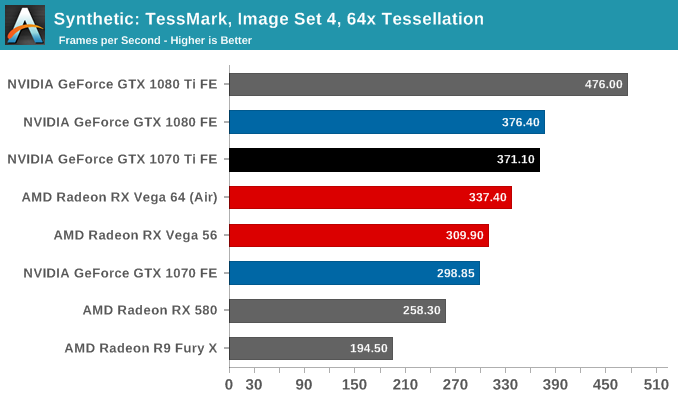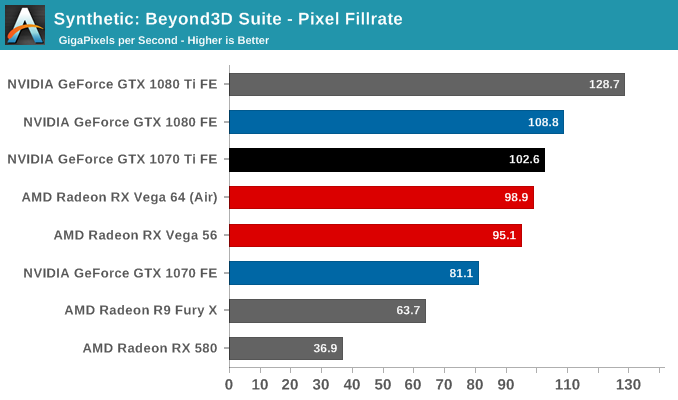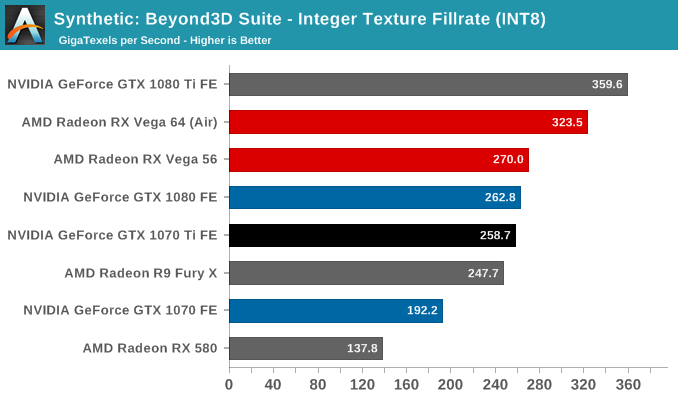The NVIDIA GeForce GTX 1070 Ti Founders Edition Review: GP104 Comes in Threes
by Nate Oh on November 2, 2017 9:00 AM EST- Posted in
- GPUs
- GeForce
- NVIDIA
- Pascal
- GTX 1070 Ti
Synthetics
Continuing onto our synthetic benchmarks, we should be able to see how the GTX 1070 Ti sits in between the GTX 1080 and 1070. These tests are more graphics focused than compute focused – especially the low-level tests – so it will be interesting to see how the GTX 1070 Ti compares to its fully-featured GP104 sibling, the GTX 1080, given how close they are so often in compute tests.

Starting off with tessellation performance, as NVIDIA's geometry performance is tied to the SMs, the GTX 1070 Ti benefits from having 3 more SMs enabled than the vanilla GTX 1070. This allows the new card to leapfrog both AMD Vega cards, coming in right behind the GTX 1080.

Switching gears, we have Futuremark's VRMark Orange benchmark. Essentially a synthetic gaming-type rendering workload with a focus on VR, this test pushes every part of a video card. Consequently, it also hits the weaker parts of the GTX 1070 Ti's configuration, particularly the lack of increased ROP throughput and memory bandwidth. As a result the GTX 1070 Ti still gains quite a bit over the GTX 1070, but it also trails the GTX 1080 by about 5%. Which, as it turns out, isn't too far removed from our general gaming benchmarks.
Finally, for looking at texel and pixel fillrate, we have the Beyond3D Test Suite. This test offers a slew of additional tests – many of which use behind the scenes or in our earlier architectural analysis – but for now we’ll stick to simple pixel and texel fillrates.

The pixel fillrate test is actually one of the more interesting results we have in today's review. While the GTX 1070 Ti doesn't get any more ROP resources on paper, pixel fillrates are a combination of both ROP (backend) and rasterizer (frontend) output. And in the case of NVIDIA's architecture, rasterization is not fully decoupled from the SMs; which is to say there's some scaling going on. And actually, this was more than I was expecting, with the GTX 1070 Ti coming very close to the GTX 1080 despite the memory bandwidth disadvantage. Not unlike tessellation performance, we see the new card leapfrog both AMD Vega cards here, pushing over 100 Gigapixels per second. In general pixel throughput is still going to be what best differentiates the GTX 1080 from the GTX 1070 Ti, but in this low-level test the two are closer than I would have expected.


Finally, for texture throughput, we're once again looking at a scenario tightly-coupled with the SM count. As a result the GTX 1070 Ti can deliver texture throughput rates very close to the GTX 1080.










78 Comments
View All Comments
Morawka - Thursday, November 2, 2017 - link
Nvidia has a ton of flawless GP104 dies stockpiled and the 1080's are selling because they use GDDR5X memory which is slower for mining. This makes perfect sense if what i describe is true. You get rid of all those extra GP104 dies by paring it with lower latency GDDR5. This card was built with miners in mind, particularly with the GDDR5 implementation. .Morawka - Thursday, November 2, 2017 - link
**Miners are not buying gtx 1080 due to slower GDDR5X. Nvidia re-engineers 1080 for better mining performance.CiccioB - Friday, November 3, 2017 - link
Your logic is somehow faulty.The chip mounted on this 1070Ti is far for allowing them to recycle any stockpile of defective chips: it requires the chip to be fully functional but a single SM (5% of the chip).
nvidia could sell much more faulty chips with the original 1070 card at whatever price seen the miners do ask for them as if they were slices of bread.
What nvidia is doing here is just creating a card that on benchmarks runs better than the concurrent card using slightly faulty chips (or disabling them on purpose), selling the card at higher price than the 1070 and just a little below the 1080.
If nvidia had lots of defective GP104 to get rid they could just have created a 1060Ti. But that would be a useless card that would compete with none but 1070, that is they would lose money by doing do.
Kevin G - Thursday, November 2, 2017 - link
AMD has had a long road to get everything integrated together but things finally seem to be falling into place with a common on-die fabric. Their previous SoC designs still had a proprietary bus for the on-die GPU. Infinity fabric is also being pushed to the GPU team for scaling up their designs as well. Long term, I would predict some GPUs falling into the same sockets as their processors for HPC workloads. This long term idea probably won't happen until they use multiple GPU dies on a single interposer.AMD had to do all this work while the company was in in the red but it looks like the results are paying off with a competitive CPU architecture again and some gains on the GPU side too. They're back in the black but I don't think AMD can afford to allocate the resources to a pure enterprise compute project. They won't ignore that market, but the base architecture will stem from the gaming side.
cwolf78 - Thursday, November 2, 2017 - link
I agree it's too expensive as well. I think this should have been set at $399. The sad part is that it's going to be impossible to find at even the MSRP in short order. I'm content to stick with my overclocked GTX 970 until this mining fad is over - or until the current crypto formats become resistant to GPU-based mining.extide - Thursday, November 2, 2017 - link
Honestly, I see nvidia phasing out the vanilla 1070 over the next few months and then sliding the 1070 Ti into the $399 price slot.CiccioB - Thursday, November 2, 2017 - link
This means nvidia is not going to sell GP104 with more than a single SM broken... which is a great waste of money for them. So no, they will keep the old card in stock and this Ti version, in fact, will be rarely found, as it is created just for looking better on charts against a no available card from the concurrent. So it does not need to be produced in mass (and probably cutting that single SM on purpose on a perfectly good die, as I do not think that the availability of GP104 with 1 bad SM can be higher that with 5 bad SM).zepi - Thursday, November 2, 2017 - link
Such chips could still be used sa GTX1070M, so there is still a product where they can be used.Not to mention that at this point of the GP104 manufacturing they should be having very nice yields already.
DanNeely - Thursday, November 2, 2017 - link
There's also the Quadro P4000 which at 14 SM enabled is the lowest end GP104 part on the market.But yeah the 1070 TI only having a single disabled SM almost certainly speaks to much higher yields since the product first launched a year and a half ago.
znd125 - Thursday, November 2, 2017 - link
Great writing and review.